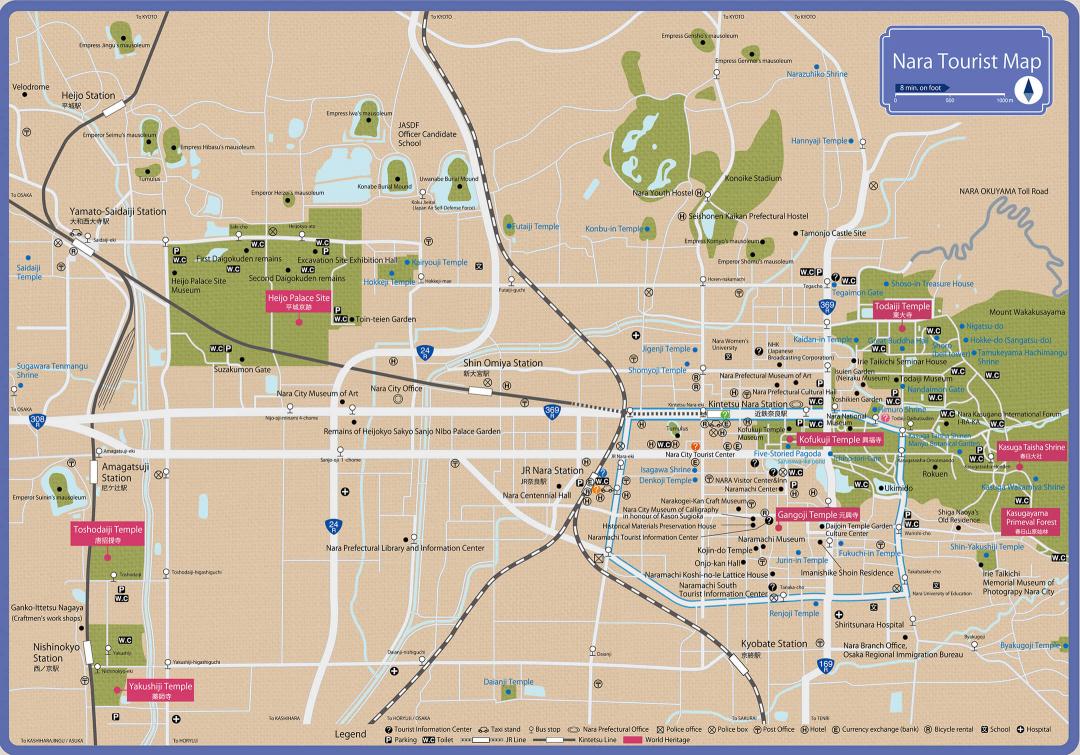![]()
World Heritage Nara Palace Site
Category: Historical Site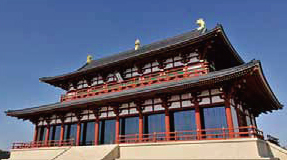
Heijō-kyō was the capital of Japan, having moved from Asuka Fujiwara-kyō in 710. The imperial domicile and government offices concentrated in Heijō Palace lie in the center. In addition to the restored Former Imperial Audience Hall (Dai-ichiji Daigokuden) and the Suzaku-mon Gate, the resource centers enable you to imagine the old times.
Address:
Former Imperial Audience Hall (Daiichiji Daigokuden)
Around Sakicho,Nara City
Suzaku-mon Hiroba Square
Around Nijo-oji-minami,Nara City
Access:
To the Former Imperial Audience Hall (Dai-ichiji Daigokuden)
25 minutes by bus from JR Nara Station
15 minutes by bus from Kintetsu Nara Station
Near the Saki-cho bus stop
15 minute walk from Kintetsu Yamato-Saidaiji Station
to Suzaku-mon-hiroba
• Approx. 20 min. walk from Yamato-Saidaiji Station(south exit)
• Approx. 20 min. walk from Shin-Omiya Station
• From Kintetsu Nara Station/JR Nara Station (west exit)
*City bus bound for Gakuen-mae Eki Get off at Suzaku-mon-hiroba mae bus stop
*Gurutto bus (runs every 20 min.mainly at weekends and national holidays; fare ¥100) to Suzaku-mon-hiroba
Inquiries:
・Former Imperial Audience Hall・ Suzaku-mon Gate・Excavation Site Exhibition Hall:Tel. 0742-32-5106 (Management office for the site of Heijō Palace, Agency for Cultural Affairs)
・Nara Palace Site Museum: Tel. 0742-30-6753 (Nara National Research Institute for Cultural Properties)
・Information Center for Reconstruction Project/Heijokyu Izanai-kan: Tel. 0742-36-8780 (Heijokyu-seki Management Center)
・Tempyo Mitsuki-kan, Tempyo Umashi-kan, Tempyo Miharashi-kan, Tempyo Tsudoi-kan, Reconstruction of Japanese Envoy Ship to Tang China, Transport Terminal: Tel. 0742-35-8201 (Heijokyo Restoration Project)
Official Website
https://www.heijo-park.go.jp/en/
Heijō-kyō Capital Site Map


The Former Imperial Audience Hall (Dai-ichiji Daigokuden)

800 meters north of the Suzaku-mon Gate lays the majestic Imperial Audience Hall. The façade is approximately 44 meters long, the sides 20 meters deep, and the height 27 meters tall. Using 44 pillars, each measuring 70 centimeters in diameter and painted in vermillion, with roughly 97,000 roofing tiles, the Former Imperial Audience Hall is the largest building in Heijō Palace. It became the kondō (main hall) of a provincial state-sponsored temple in Yamashiro Province, when the capital was temporarily moved to Kuni-no-miya in the middle of the Nara period.
Nara Palace Site Museum
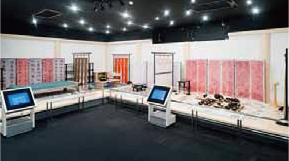
Photograph source: Nara National Research Institute for Cultural Properties
Based on the findings from the research and excavation done by the Nara National Research Institute for Cultural Properties, artifacts such as earthenware, roofing tiles, and mokkan (narrow strips of wood on which official messages were written in the Nara period), as well as models of structures, aerial photographs, and diorama of excavation sites and models, etc. are used to display Heijō Palace in a way that is easy to understand.
Reconstruction Project Information Center (Fukugen-jigyō-jōhōkan)
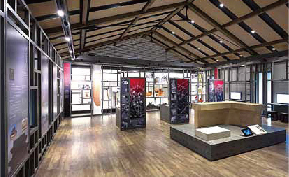
While using CG images, tools, and samples of reference materials, etc., to introduce the Former Imperial Audience Hall (Dai-ichiji Daigokuden) Reconstruction Project, the center offers hands-on learning opportunities about ancient technology.
The Excavation Site Exhibition Hall
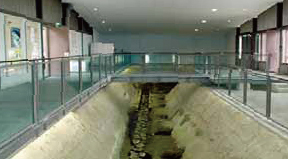
You can observe relics just as they were discovered during excavations. Model reconstructions of the imperial domicile and city hall are displayed here.
The East Palace Garden
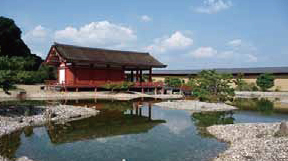
Heijō Palace has an extended eastern wing which is a unique example of palace sites in ancient Japanese castle towns. The southern part of the site was called tōgū or tōin, literally East Palace, where the palace of the Crown Prince was located. In the southeast end of the site, there is a pond running 60 meters east to west and 60 meters south to north, the East Palace Garden surrounding the pond.
Suzaku-mon Gate
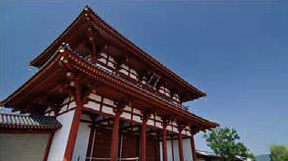
The main gate of Heijyō Palace is called Suzaku-mon Gate. In front of the gate, emissaries from foreign countries were welcomed and sent off and large crowds gathered there to hold such events as festive dancing and singing. On the New Year, the emperor sometimes went to the gate to conduct the New Year’s celebration. An earthen wall of 5.5 meters high extends to the right and left of the Suzaku-mon Gate, encircling the 130 hectare imperial palace.
Heijokyu Izanai-kan(Guidance Center)
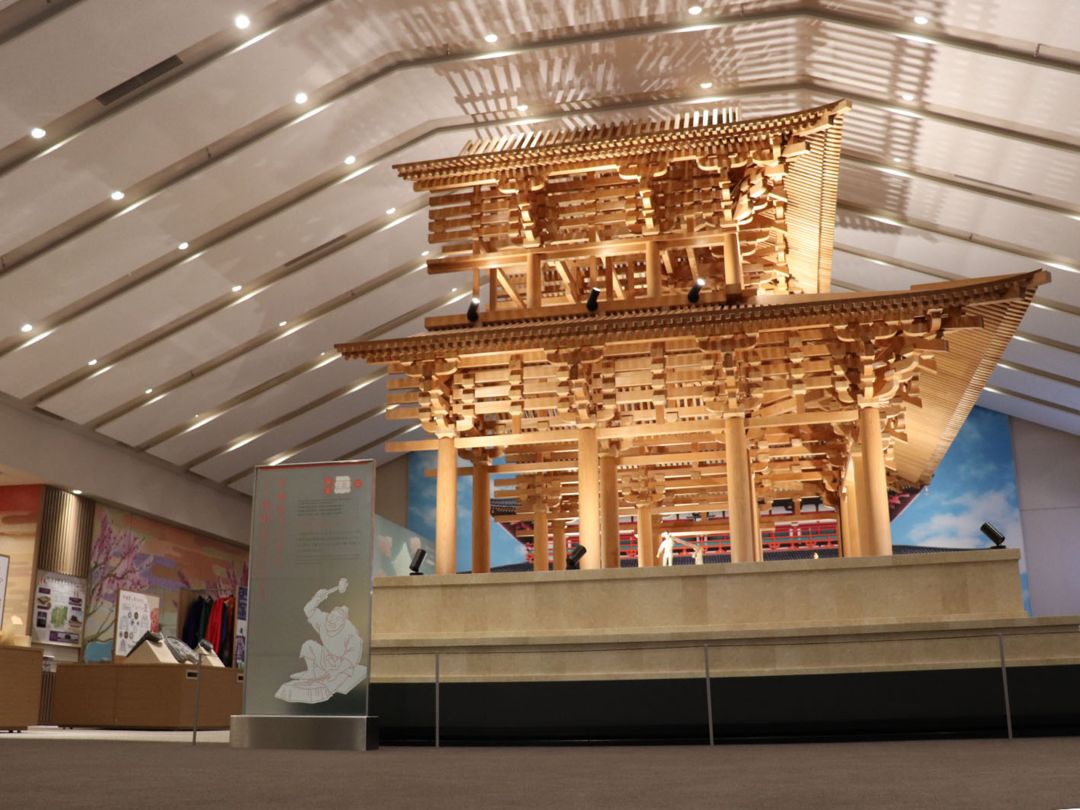
Heijokyu Izanai-kan is an interpretive center which explains the signi cance and splendor of the Heijokyu-seki Rekishi Koen (Nara Palace Site Historical Park), and invites you to the palace site, which evokes the spirit of ancient times.
Tempyo Umashi-kan(Restaurant and Cafe)
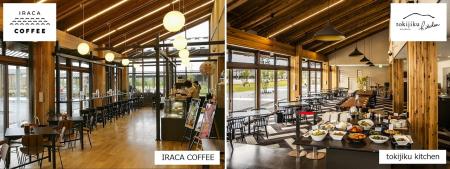
Pass through the kentoshi envoy ship explanation area and visit a reconstructed ship. Relax in the park restaurant and cafe and enjoy the view over the park. We also have an event space in which we hold workshops and exhibitions.
Tempyo Miharashi-kan(Observation Deck)
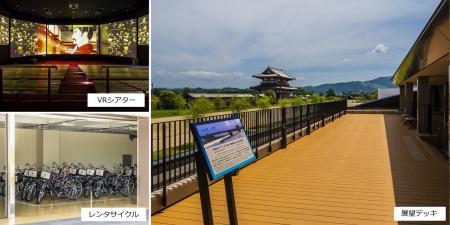
Enjoy the view over the Nara Palace Site from the observation deck and observation room.Audio-visual presentations are shown in our VR theater. We also have a bicycle rental shop, and a jogging/cycle station.
Tempyo Mitsuki-kan(Shops)
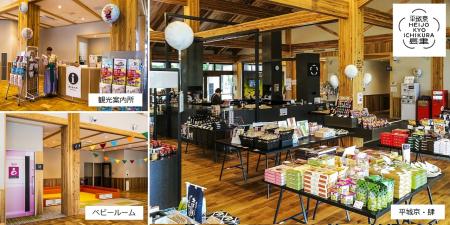
A large selection of Nara Prefecture tourist information.On sale are local specialties and products from Heijo-kyo,the international city of the Nara Period.
Tempyo Tsudoi-kan(Information)
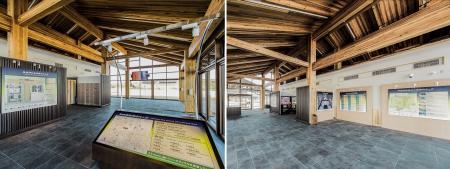
Meeting point for school trips and tour groups, provides information about all the facilities in the park.
Reconstruction of Japanese Envoy Ship to Tang China
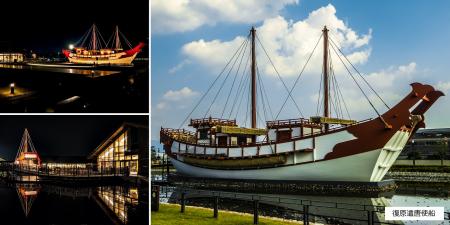
For over 200 years, an envoy was sent to Tang China, the first in 630 A.D., and the last in 838 A.D. Those who rode the ship, replicated here, risked their lives in making the crossing to Tang China, and brought back technology and culture that contributed to the development of Nara-period Japan. "Mist is sprayed and music played every hour on the hour and at half past. The ship is lit up from 6:00 pm.
Closed:
Former Imperial Audience Hall, Suzaku-mon Gate, Excavation Site Exhibition Hall, Nara Palace Site Museum: Closed Mondays (but open Monday and closed the next day if Monday is a national holiday) and from December 28 to January 3.
Information Center for Reconstruction Project, Heijokyu Izanai-kan: Closed second Monday in February, April, July, November (but open Monday and closed the next day if Monday is a national holiday) and from December 29 to January 1.
Tempyo Miharashi-kan: Closed Mondays (but open Monday and closed the next day if Monday is a national holiday) and at year-end/New Year.
Tempyo Mitsuki-kan, Tempyo Umashi-kan, Tempyo Tsudoi-kan, Reconstruction of Japanese Envoy Ship to Tang China: Open 365 days a year.
Hours:
Former Imperial Audience Hall, Suzaku-mon Gate, Excavation Site Exhibition Hall, Nara Palace Site Museum: 9:00 a.m. - 4:30 p.m.
Information Center for Reconstruction Project, Heijokyu Izanai-kan: 10:00 a.m. - 6:00 p.m. (until 6:30 p.m. June to September)
Tempyo Miharashi-kan: 9:00 a.m. - 5:00 p.m.
Tempyo Tsudoi-kan: 9:30 a.m. - 6:00 p.m.
Tempyo Mitsuki-kan:[Tourist Information Center] 9:30 a.m. - 6:00 p.m. [Sales of goods] 9:30 a.m. - 9:00 p.m.
Tempyo Umashi-kan: Cafe: 9:30 a.m. - 10:00 p.m.Restaurant: 11:00 a.m. - 2:00 p.m./5:00 p.m. - 10:00 p.m. (reservation required) Reconstruction of Japanese Envoy Ship to Tang China: 9:30 a.m. - 6:00 p.m.
Sightseeing Spots in the area
| Kairyuouji Temple >tap for details |
| Hokkeji Temple >tap for details |
| Saidaiji Temple >tap for details |
| Akishinodera Temple >tap for details |
World Heritage Historic Monuments of Ancient Nara
>>Nara City Sightseeing Guide top
